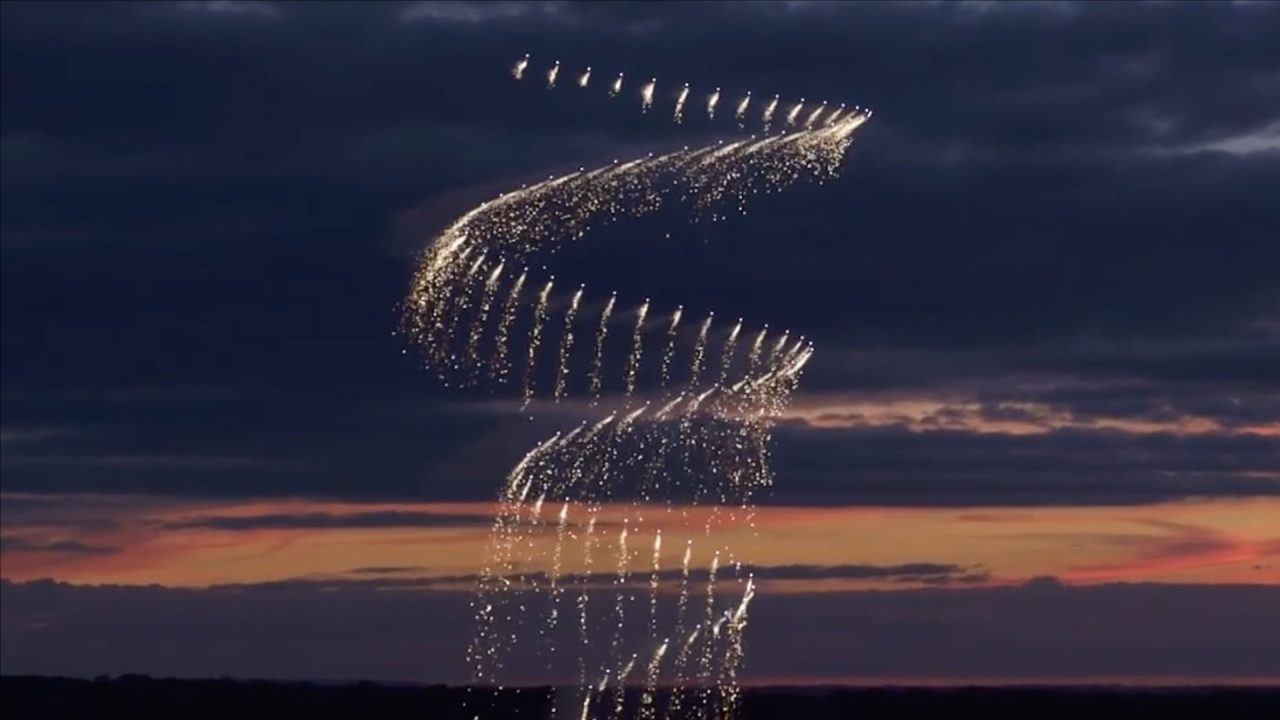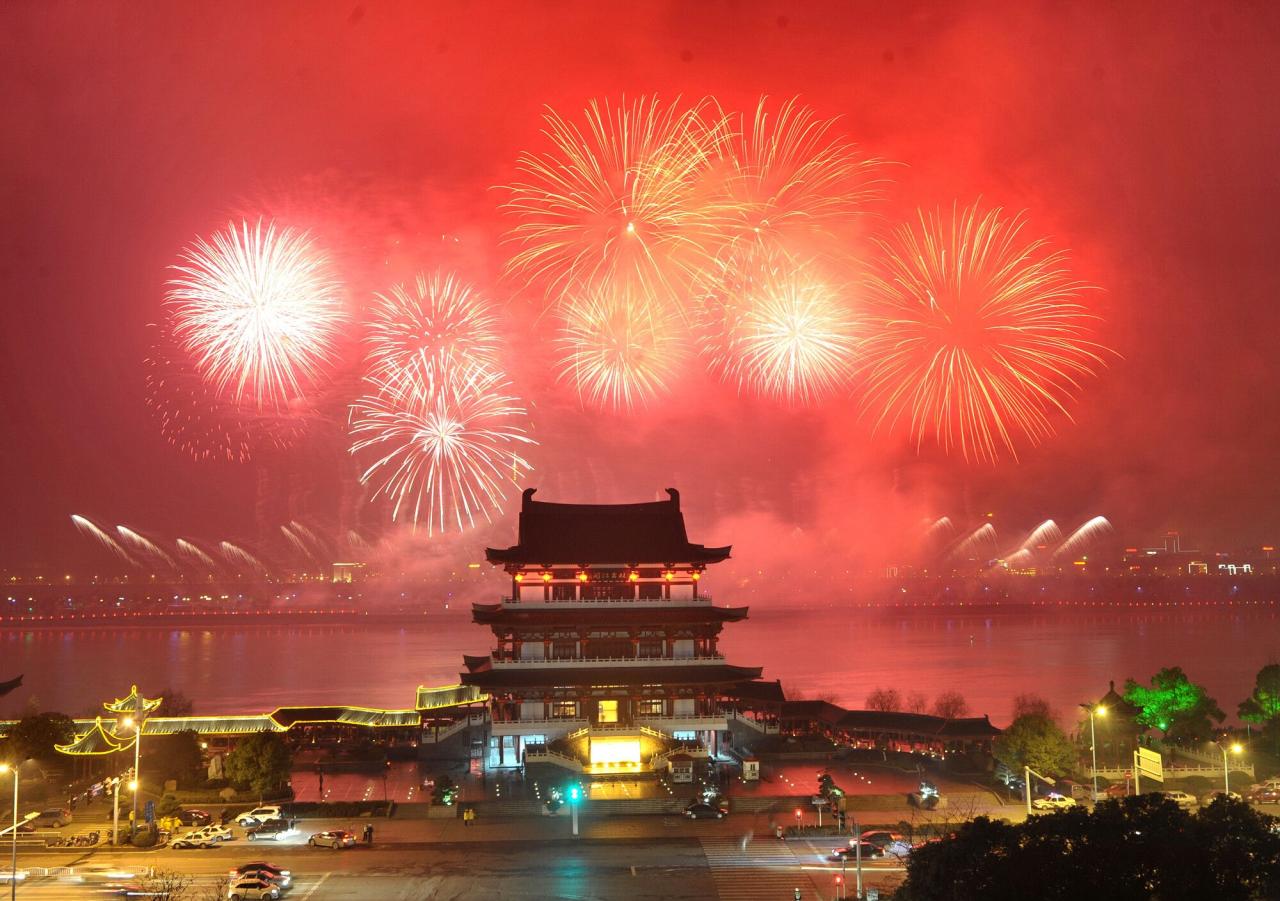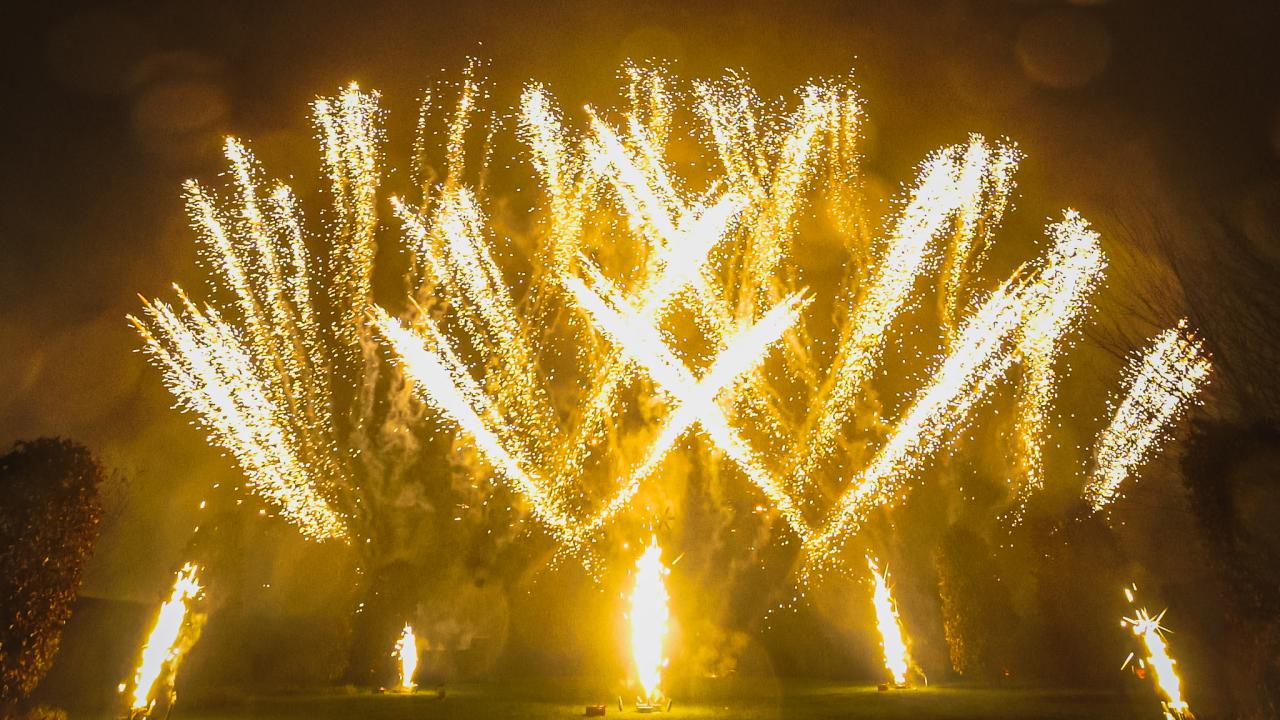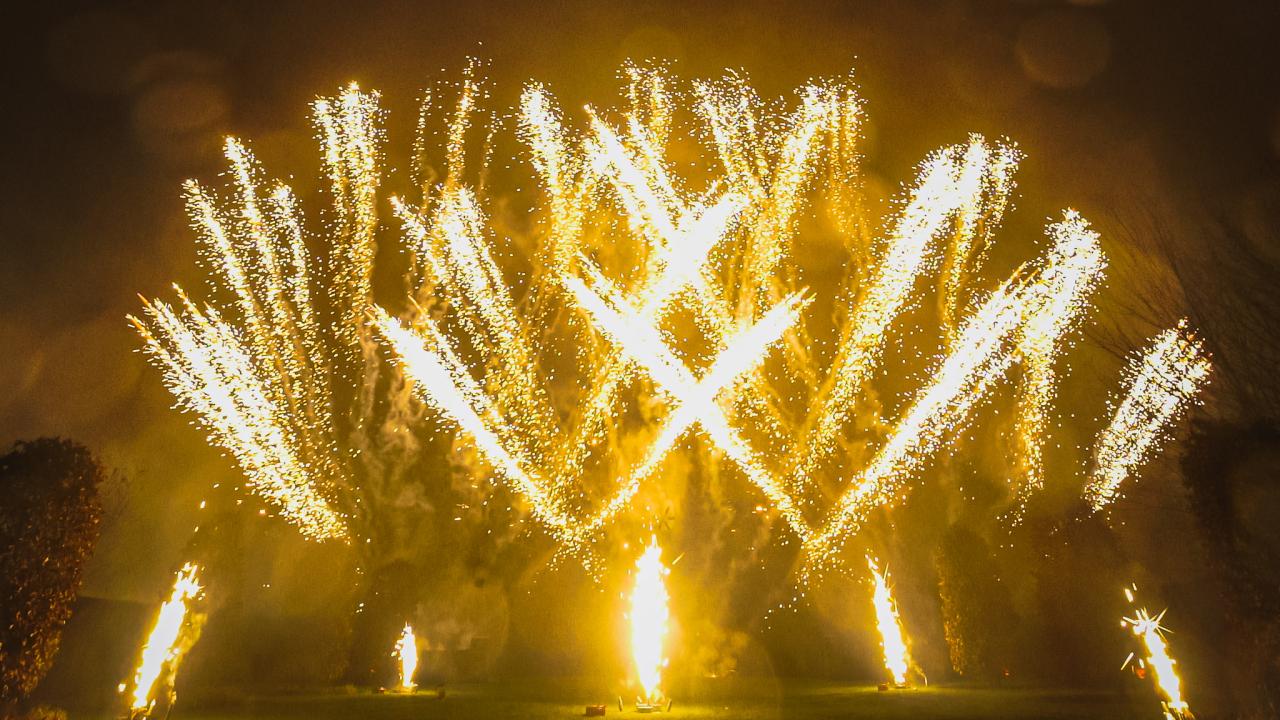Drone fireworks China are transforming nighttime entertainment. These dazzling displays, orchestrated by fleets of synchronized drones, offer a vibrant, eco-friendly alternative to traditional fireworks. This exploration delves into the history, technology, economic impact, safety regulations, and societal implications of this burgeoning industry, highlighting its unique position in China and its global potential.
From humble beginnings to becoming a multi-million dollar industry, the use of drones for spectacular light shows in China has been nothing short of revolutionary. Technological advancements have allowed for increasingly complex and breathtaking displays, pushing the boundaries of what’s possible in pyrotechnics. We’ll examine the key milestones in this evolution, the business models driving innovation, and the regulations ensuring safe and responsible use.
The Rise of Drone Fireworks in China
China’s adoption of drone light shows marks a significant shift in the fireworks industry, blending technological innovation with traditional spectacle. This evolution has been rapid, driven by advancements in drone technology and a growing demand for environmentally friendly alternatives to traditional fireworks.
History and Evolution of Drone Light Shows
The use of drones for light shows in China began relatively recently, gaining significant traction in the mid-2010s. Early displays were smaller and less sophisticated, but rapid technological advancements quickly led to larger, more complex, and visually stunning performances. Initially, these displays were primarily used for special events and celebrations, but their popularity has since expanded to encompass a wider range of applications.
Technological Advancements Enabling Drone Light Shows
Several key technological advancements have fueled the rise of drone light shows. These include improvements in drone battery life, GPS accuracy, flight control systems, and LED lighting technology. Miniaturization of components has also played a crucial role, allowing for more drones to be deployed in a given space, resulting in greater complexity and visual impact.
Environmental Impact Comparison, Drone fireworks china
Drone light shows offer a significantly more environmentally friendly alternative to traditional fireworks. Traditional fireworks generate significant air and noise pollution, along with considerable waste. Drone light shows, in contrast, produce minimal pollution and leave no debris behind, making them a sustainable choice for large-scale events.
Timeline of Key Milestones
A timeline illustrating the key milestones in the development and adoption of drone fireworks in China would include:
- 2015-2016: Early experimental drone light shows, limited in scale and complexity.
- 2017-2018: Significant increase in the scale and sophistication of displays, driven by technological advancements.
- 2019-2020: Widespread adoption of drone light shows for major events and celebrations across China.
- 2021-Present: Continued innovation and refinement of drone light show technology, with increasing emphasis on sustainability and safety.
Economic Impact and Business Models
The drone fireworks industry in China presents significant economic opportunities, generating revenue through show production, drone sales, software development, and related services. Diverse business models have emerged to capitalize on this growing market.
China’s drone fireworks displays are becoming increasingly popular, offering spectacular light shows without the environmental impact of traditional fireworks. However, the technology involved highlights the importance of safety regulations, especially considering recent tragic events like the plane crashes south korea which underscore the need for robust oversight in all areas of aerial technology. This makes the careful development and deployment of drone fireworks even more crucial for ensuring safe and enjoyable public events.
Economic Benefits and Opportunities
The industry creates jobs in technology, engineering, event management, and related fields. It also boosts tourism and local economies by attracting spectators to large-scale events. The revenue generated from these events contributes significantly to the overall economic growth of the regions involved.
Examples of Business Models

Companies offering drone light shows utilize various business models, including direct sales to event organizers, subscription services for recurring displays, and partnerships with tourism agencies. Some companies focus on specialized show designs, while others offer complete event management services.
Challenges and Risks
Challenges include high initial investment costs for equipment, intense competition, stringent safety regulations, and potential for technological malfunctions during performances. Weather conditions also pose a significant risk, requiring contingency plans and potentially leading to cancellations or postponements.
Cost and Benefit Comparison of Different Show Sizes
| Show Size (Number of Drones) | Estimated Cost (USD) | Visual Complexity | Potential Revenue (USD) |
|---|---|---|---|
| Small (100-500) | 5,000 – 25,000 | Simple patterns, basic animations | 10,000 – 50,000 |
| Medium (500-1000) | 25,000 – 50,000 | More intricate designs, dynamic animations | 50,000 – 100,000 |
| Large (1000+) | 50,000+ | Highly complex and detailed displays, 3D formations | 100,000+ |
Safety and Regulatory Aspects
Safety is paramount in drone light shows. Stringent regulations and guidelines are in place to minimize risks and ensure safe operations. Government agencies play a crucial role in overseeing these operations.
Safety Regulations and Guidelines
Regulations cover aspects such as drone registration, pilot licensing, flight planning, airspace restrictions, and emergency protocols. These guidelines aim to prevent accidents and mitigate potential hazards associated with large-scale drone operations.
Potential Safety Hazards and Mitigation Strategies
Potential hazards include drone malfunctions, collisions, loss of control, and interference with other aircraft. Mitigation strategies involve rigorous pre-flight checks, redundant systems, skilled operators, and comprehensive safety protocols. Emergency response plans are also essential.
Role of Government Agencies
Government agencies are responsible for enforcing safety regulations, issuing permits, and overseeing the operation of drone light shows. They conduct inspections, investigate incidents, and work to continuously improve safety standards within the industry.
Approval Process Flowchart
A flowchart for a large-scale drone firework display approval would involve steps such as application submission, site assessment, flight plan review, safety inspection, permit issuance, and ongoing monitoring during the event.
Public Perception and Social Impact

Public reaction to drone light shows in China has been largely positive, with displays often met with awe and excitement. The technology has become integrated into various cultural events, creating new forms of entertainment and spectacle.
Public Reactions and Cultural Significance
Many view drone light shows as a modern and innovative form of entertainment, offering a visually stunning alternative to traditional fireworks. Their integration into festivals and celebrations has been largely welcomed.
Impact on Traditional Celebrations
While some may see drone light shows as a replacement for traditional fireworks, others view them as a complementary addition, enhancing existing celebrations with a unique technological element. The integration varies depending on the specific cultural context and event.
Societal Benefits and Drawbacks
- Benefits: Reduced pollution, economic growth, new forms of entertainment, technological innovation.
- Drawbacks: High initial investment costs, potential job displacement in traditional fireworks industry, potential for misuse of technology.
Technological Innovations and Future Trends
Ongoing technological advancements promise even more spectacular and sophisticated drone light shows in the future. This includes innovations in drone design, software, and lighting technologies.
China’s drone fireworks displays are getting increasingly popular, offering spectacular light shows. However, the recent tragic events, like the ones reported in the south korea plane crash news , remind us of the importance of safety regulations and responsible technology use. This underscores the need for stringent safety protocols in all aerial displays, including those using drone fireworks in China.
Emerging Technologies
Advancements in artificial intelligence (AI) could enable autonomous choreography and real-time adjustments to displays based on audience response. Improved battery technology will extend flight times, allowing for longer and more complex shows. More sophisticated lighting systems could enable a wider range of colors and effects.
Future Applications Beyond Fireworks

Drone technology has applications beyond fireworks, including aerial photography, surveillance, delivery services, and search and rescue operations. The advancements in this sector are continuously expanding its applications in various fields.
Capabilities of Different Drone Types
Different drones offer varying capabilities in terms of payload capacity, flight time, maneuverability, and lighting features. Larger drones can carry more lights and create more complex formations, while smaller drones offer greater agility and maneuverability for intricate designs.
Conceptual Illustration of a Future Drone Light Show
Imagine a future drone light show featuring thousands of synchronized drones forming intricate three-dimensional sculptures in the sky, incorporating holographic projections and interactive elements responding to audience participation. The drones would be equipped with advanced AI-powered flight control and lighting systems, creating an immersive and breathtaking spectacle unlike anything seen before.
International Comparisons and Global Market: Drone Fireworks China
While China is a leading innovator and adopter of drone light shows, the technology is gaining traction globally. This presents opportunities for the export of Chinese technology and expertise.
International Development and Adoption
Other countries are also exploring the use of drone light shows, but China remains at the forefront in terms of scale, sophistication, and frequency of displays. The adoption rate varies depending on factors such as regulatory frameworks, technological infrastructure, and cultural acceptance.
Potential for Export
Chinese companies have a significant opportunity to export their drone light show technology and services to other countries. This could involve the sale of drones, software, and expertise in show design and production.
Key Players and Competitors
The global drone light show market is becoming increasingly competitive, with companies from China, the US, Europe, and other regions vying for market share. The competitive landscape is dynamic, with continuous innovation and consolidation.
Regulatory Landscapes in Different Countries
| Country | Regulatory Body | Key Regulations | Ease of Obtaining Permits |
|---|---|---|---|
| China | CAAC (Civil Aviation Administration of China) | Strict regulations on drone operations, airspace restrictions | Moderate |
| United States | FAA (Federal Aviation Administration) | Regulations on drone registration, pilot certification, flight restrictions | Moderate to Difficult |
| United Kingdom | CAA (Civil Aviation Authority) | Regulations on drone registration, operator competency, airspace restrictions | Moderate |
Final Review
Drone fireworks in China represent more than just a spectacular show; they symbolize a technological leap forward in entertainment and a shift towards sustainable celebrations. While challenges remain regarding safety and regulation, the industry’s potential for economic growth and cultural impact is undeniable. As technology continues to advance, we can expect even more breathtaking displays and innovative applications of drone technology in the years to come, both within China and across the globe.
Popular Questions
What are the environmental benefits of drone fireworks compared to traditional fireworks?
Drone light shows produce significantly less air and noise pollution, and generate no harmful debris.
How much does a typical drone fireworks show cost?
Costs vary greatly depending on the size, complexity, and duration of the display. Smaller shows can cost a few thousand dollars, while large-scale events can cost hundreds of thousands.
China’s drone fireworks displays are becoming increasingly popular, offering spectacular, large-scale shows. However, the recent advancements in drone technology also highlight safety concerns, much like the tragic events surrounding the plane crashes south korea which underscore the need for robust safety regulations. Therefore, ensuring responsible development and deployment of drone technology, including for fireworks, is crucial for preventing future incidents.
What kind of training is needed to operate drones for fireworks displays?
Operators require specialized training in drone piloting, flight planning, and synchronization software, often involving certification and licensing.
Are there any international safety standards for drone fireworks?
While regulations vary by country, international organizations are working towards developing standardized safety guidelines for drone operations, including those involving fireworks.
